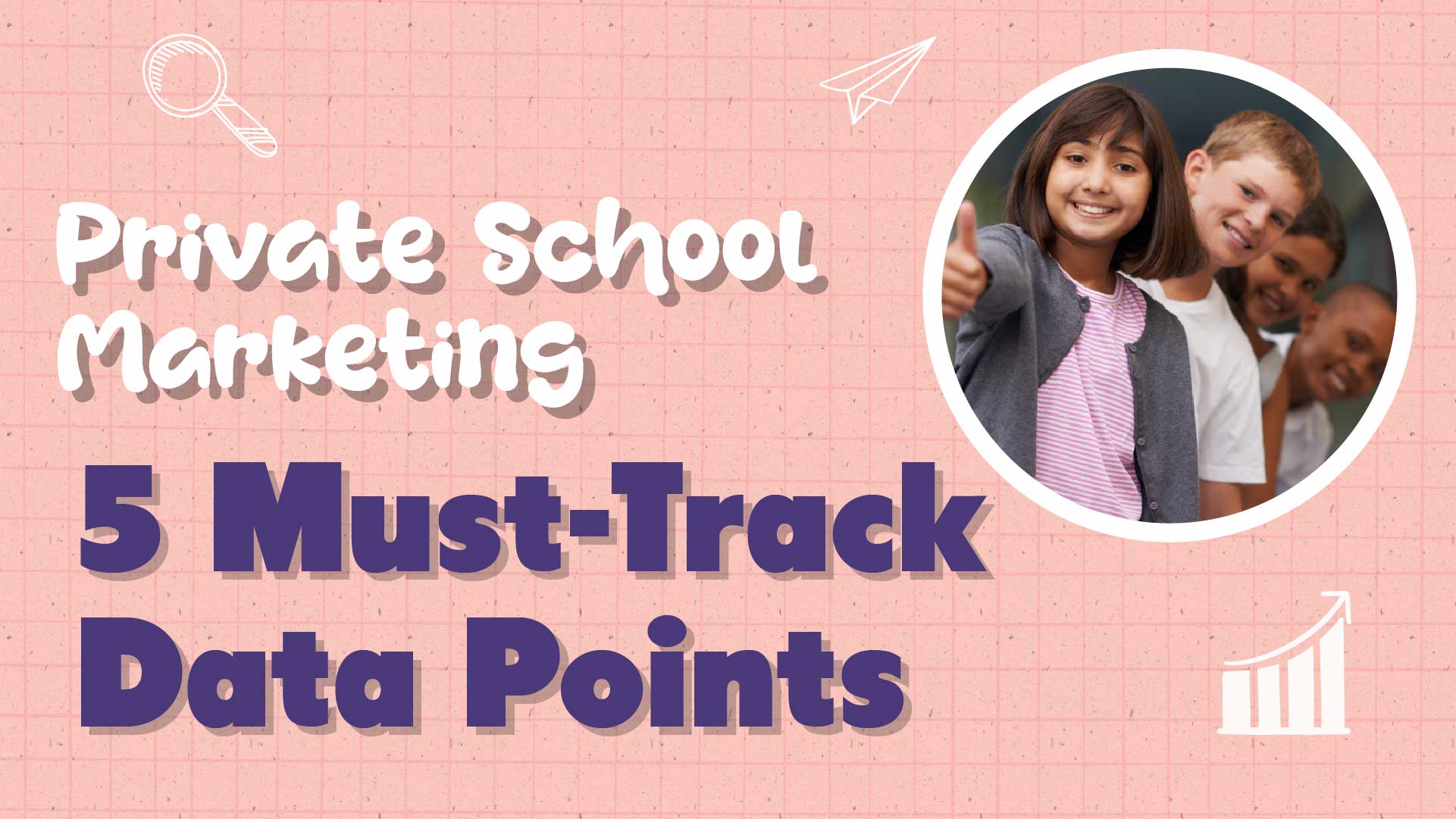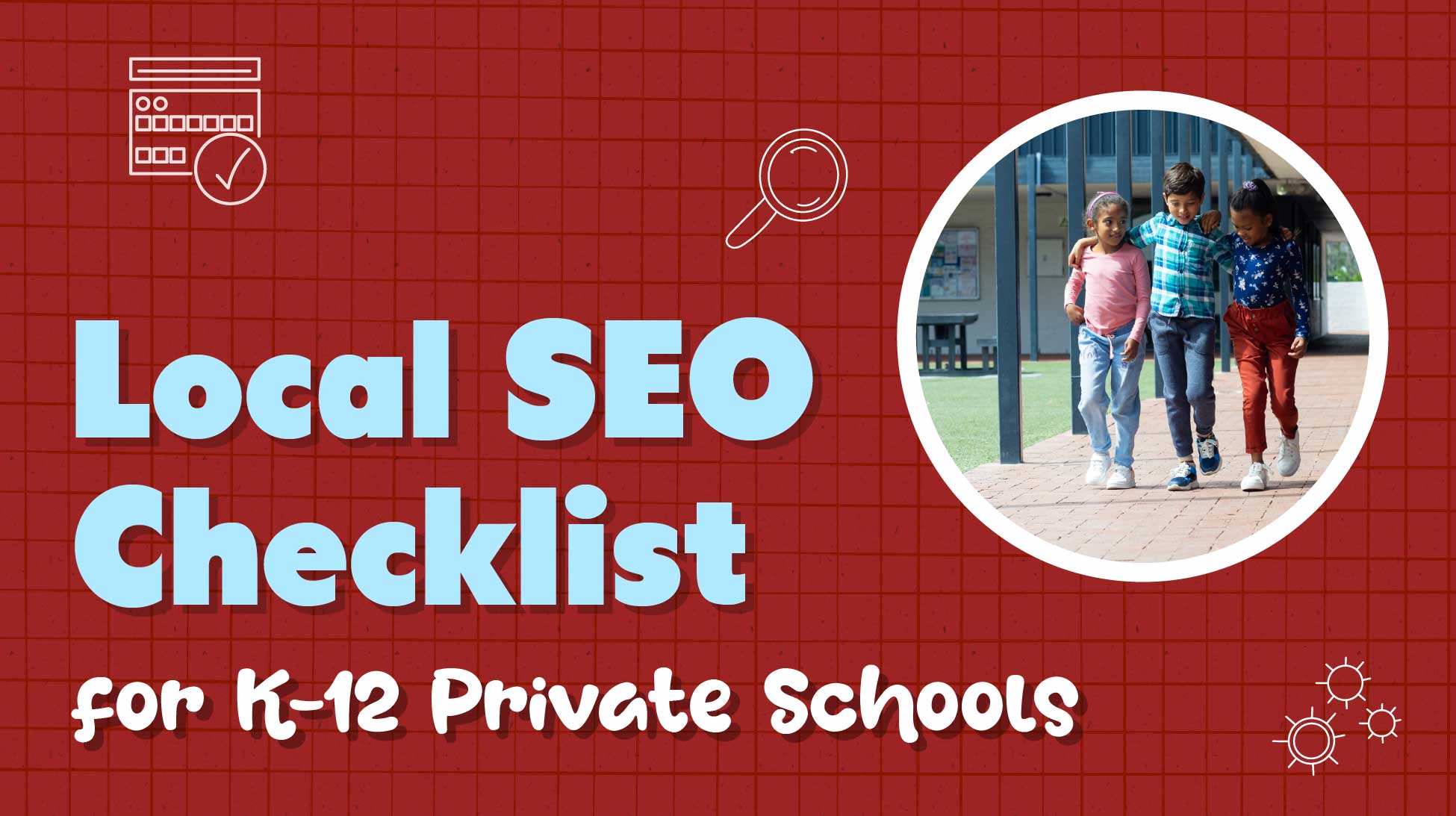Private school administrators and principals understand the need for marketing, yet according to a report from Angela Brown at Niche.com, validating the impact of these efforts remains a challenge. Studies have shown that more than 7 out of 10 private school marketers need help quantifying the impact of their strategies. With many tools at their disposal in the digital age, there is no excuse for neglecting the tracking, analysis, and reporting of marketing data.
Tracking the right metrics gives school marketers perspective. Gaining insight into your analytic results helps you set goals and reasonable expectations. Let's take our fictional Greenfield Academy as an example. Let's suppose they currently have 2,500 users on their website per month. During goal-setting conversations, someone suggested that it should be 10,000 users per month. Unfortunately, this was unreasonable, given their location and budget. A more realistic goal would be 5,000 website users per month.
Social media analytics are similarly useful. For example, Greenfield can track the engagement metrics on their social media channels to help determine future content topics.
In today’s technology age, many digital marketing tools offer school marketers unprecedented data. This can pose a challenge for marketers, who can spend too much time on analytics that may not prove advantageous. School marketers need to be measuring the right metrics.
In the technology-driven landscape, an abundance of digital marketing tools empowers administrators. However, the challenge lies in avoiding excessive focus on non-advantageous analytics. Private school administrators must prioritize measuring metrics aligned with guiding principles:
- Set Clear Goals: Establish metrics at the beginning of the year to align the marketing team with achievable objectives.
- User-Friendly Metrics: Ensure metrics are easy to understand and use for effective decision-making.
- Comparative Analysis: Facilitate easy comparison of metrics from one period to the next for ongoing assessment.
- Actionable Impact: Metrics should be useful, actionable, and contribute positively to the school's overall impact.
Top 10 Metrics School Marketers Need to Measure
1. Website Traffic
Understanding website traffic is crucial for private school administrators and principals to gauge online engagement. This metric reveals the number of visitors within a specific timeframe and provides insights into traffic sources.
Quantifying Engagement:
- Measure the number of website visitors over defined periods to assess the effectiveness of your digital marketing strategies.
- Break down traffic into source/medium categories to identify the origin of visitors and tailor strategies accordingly.
Long-Term Measurement:
- Track website traffic consistently over time to observe patterns and ensure continuous improvement.
- A positive trend in overall traffic indicates effective outreach efforts and engagement.
Practical Measurement Steps:
- Utilize Google Analytics for detailed insights into website performance.
- Access key traffic data in the Acquisition > Overview > Sessions section.
- Customize the timeframe for analysis, with a recommended minimum of the last 30 days for a comprehensive review.
Keeping abreast of website traffic trends empowers private school administrators to tailor their digital presence effectively, ensuring sustained growth and engagement.
2. Channel-Specific Traffic
Understanding channel-specific traffic is crucial for private school administrators and principals seeking actionable insights into their website's performance. This knowledge not only helps identify preferred audience channels but also assists in addressing issues leading to drops in visits.
- Relevant Metrics for Private Schools: Focus on the nine key channels used to measure website traffic in Google Analytics, tailored to the context of private schools.
- Organic Search: Emphasize the significance of organic search, highlighting visitors who find the school website through search engine queries.
- Social Media Impact: Highlight the social channel, measuring the number of visitors arriving from various social media platforms, reflecting the school's online presence.
- Direct Engagement: Clarify the direct channel's importance, showcasing visitors who directly type the school's URL or have previously visited, indicating engaged and returning audiences.
- Referral Insights: Stress the referral channel, indicating visits from external websites, directories, or other domains, showcasing the school's broader online reach.
- Paid Campaigns and Email Outreach: Emphasize the significance of paid search, email, and display channels, showcasing the impact of PPC campaigns, email marketing, and advertising on website traffic.
- Affiliate and Other Advertising: Discuss the channels of affiliates and other advertising, highlighting the diverse sources contributing to website traffic.
- Customized Channel Analysis: Encourage administrators to view channel-specific traffic under the website traffic metrics section for a comprehensive understanding.
3. Conversions
In the dynamic landscape of private school administration, conversions have evolved beyond mere online purchases. In today's digital era, understanding user actions is paramount for administrators and principals to enhance their school's online presence.
Broadened Definition of Conversions: In the current digital context, conversions extend beyond purchases, encompassing desired actions like inquiry form submissions, newsletter sign-ups, or ebook downloads.
Strategic Importance of Tracking Conversions: Tracking conversions is a strategic necessity. A low conversion rate may signal issues like website design flaws, unattractive offers, or a disinterested audience. For private school administrators, this insight is invaluable.
Identifying User Interaction Patterns: Conversions tracking enables administrators to discern user interactions with different aspects of the school's website. This understanding is pivotal in refining and optimizing the online experience for visitors.
Indicators for Website Enhancement: A low conversion rate is a red flag, prompting administrators to contemplate website redesigns or updates to the inquiry funnel. This proactive approach ensures that the school's online presence aligns with evolving user expectations.
Practical Steps for Conversions Analysis: Accessing conversion data can be streamlined through Google Analytics
- Navigate to Conversions > Goals > Overview > Source/Medium from your Google Analytics dashboard.
- Customize the timeframe for a comprehensive analysis by selecting the desired duration in the upper right corner.
- Click "View Full Report" to delve into detailed insights.
4. Bounce Rate
Understanding and managing bounce rates is crucial for private school administrators and principals aiming to optimize their online presence. Bounce rate, representing the percentage of visitors leaving the site without exploring further, is a key metric that requires attention.
Defining Bounce Rate for Private Schools: The bounce rate reflects the average number of website visitors exiting from the same landing page without navigating to other pages. For private schools, a low bounce rate is essential to encourage exploration of the site's content.
Page-Specific Insights: Recognizing that each page on the school's website has its own bounce rate provides administrators with valuable page-specific information. This insight aids in pinpointing areas for improvement.
Optimal Bounce Rate Target: Private school administrators should aim for a general bounce rate of 30 percent or less. A higher rate than this benchmark necessitates strategic interventions to enhance user engagement.
Viewing Bounce Rate by Channel: Accessing Google Analytics allows administrators to analyze bounce rates by channel.
- Navigate to Acquisition > All Traffic > Channels on the Google Analytics dashboard.
- Choose a specific channel to evaluate its performance.
- Select a timeframe for analysis in the upper right corner.
- Review the Bounce Rate column for insights.
Analyzing Bounce Rate by Page: Administrators can delve into page-specific bounce rates for a more granular understanding.
- Visit Behavior > Site Content > All Pages or Landing Pages in the Google Analytics dashboard.
- Choose the desired timeframe for analysis.
- Examine the Bounce Rate column to identify pages that may require optimization.
Implementing these strategies empowers private school administrators to enhance user engagement and create an inviting online environment.
Additional Help: Google Analytics 4 Industry Benchmarks for 2023 and Beyond
5. Search Trends
For private school administrators and principals, harnessing the power of search trends is paramount in refining marketing strategies. Analyzing Search Trends ensures your campaigns are honed to target the most effective keywords. Moreover, cross-referencing Search Trends with Overall Traffic helps discern shifts in performance linked to evolving Search Trends.
To effectively gauge Search Trends, follow these steps tailored for private schools:
- Navigate to Google Trends: Access Google Trends to comprehensively analyze your selected search term.
- Keyword Precision: Enter the specific search term relevant to your campaigns.
- Geographical Optimization: Optimize your search by choosing a broad scope, such as the United States, or refine it to a smaller region for localized insights.
- Precision Drill-Down: For nuanced insights, narrow the search to a smaller geographical area, leveraging available data.
- Leverage Related Search Terms: Capitalize on Google's capability to generate related search terms. This feature unveils additional keywords crucial for targeted campaigns.
6. New Vs. Returning Users
For private school administrators and principals, understanding website metrics is crucial in evaluating the success of attracting new visitors and optimizing outreach campaigns. A key metric for this assessment is the "New Users" category, which illuminates the effectiveness of your site in engaging fresh visitors and gauges the performance of outreach initiatives.
To delve into these insights:
- Access Relevant Reports: Navigate to your analytics dashboard, specifically focusing on reports such as Acquisition > All Traffic > Channels.
- Explore the New Users Column: Within the chosen report, analyze the New Users column to understand the influx of fresh visitors to your site.
- Percentage of New Sessions: Evaluate the percentage of new sessions, an invaluable indicator accessible from the report, to gauge the overall success of your website in fostering new user engagement.
By honing in on the "New Users" metric within these reports, private school administrators can make informed decisions to optimize their online presence and outreach strategies, ensuring a dynamic and engaging digital experience for prospective students and parents.
7. Queries
In private school administration, understanding user queries is paramount for optimizing online presence. Query insights unveil the specific searches leading individuals to your website. To harness this valuable information:
- Link Google Search Console to Google Analytics: Ensure your Google Search Console is linked to your Google Analytics account. This integration is foundational for accessing query data.
- Configuring Search Console in Google Analytics: Follow these steps to configure the Search Console in Google Analytics seamlessly, enabling a cohesive view of your website's performance.
- Explore Queries in Google Analytics: Once integrated, navigate to Acquisition > Search Console > Queries in your Google Analytics dashboard. This section provides a detailed breakdown of the queries bringing users to your site.
By focusing on these query insights, private school administrators and principals can adapt their digital strategies to align with their target audience's specific interests and inquiries, fostering a more engaging and responsive online experience.
8. Top Organic Landing Pages
Understanding online visibility is crucial for effective digital strategies in private school administration. The "Top Organic Landing Pages" metric provides valuable insights into the pages most visible to search engines, offering a window into user interests and the effectiveness of SEO efforts.
Key Benefits:
- Visitor Interest Analysis: Identify the most visited pages, revealing specific content that engages your audience.
- Optimization Assessment: Evaluate how well pages are optimized for search engines, indicating areas for improvement.
- SEO Strategy Review: Determine the need to adjust your SEO strategy based on page performance.
Measuring Top Organic Landing Pages:
- Navigate to Behavior > Site Content > Landing Pages in your Google Analytics dashboard.
- In the Secondary Dimension dropdown, select Acquisition > Medium to focus on organic traffic.
- Click "Advanced" near the search bar and create a filter showing only "Medium" with "Organic" in the containing-only field.
- Click "Apply" to generate insights tailored to organic search visibility.
By adopting this data-led metric, private school administrators and principals can fine-tune their online presence, ensuring alignment with audience interests and maximizing the impact of their digital efforts.
9. User Demographics
In private school administration, harnessing Google Analytics becomes paramount for informed decision-making. User demographics, a key facet, offer crucial insights for administrators and principals. The pivotal metric for educational institutions lies in location information, ensuring precise targeting of marketing efforts.
Strategic Implementation
- Access Location Metrics: Navigate to Audience > Geo > Location in your Google Analytics dashboard.
- Define Measurement Timeframe: Set the desired timeframe in the upper right corner to align with your strategic objectives.
- In-depth analysis: Drill down into the metrics to comprehensively understand user engagement in regional and city locations.
Significance for Schools:
- Targeted Marketing: Pinpoint the geographic areas where your audience resides, allowing tailored marketing strategies.
- Resource Optimization: Allocate resources effectively by focusing efforts where engagement and interest are most pronounced.
- Strategic Decision-Making: Equip administrators with the data needed to make informed decisions about outreach and enrollment initiatives.
Private school administrators can refine their marketing approach by delving into location-based metrics, ensuring a localized and impactful connection with their audience.
Additional Help: Google Analytics Audiences: Overview + How to Use Them
10. Brand Sentiment
Monitoring brand sentiment through specialized tools is crucial for private school administrators. By utilizing platforms like Mention, GigaAlert, Talkwalker, and Google Alerts, administrators can proactively engage with the school's online narrative and swiftly address emerging concerns or praises.
In Closing
In today's digital landscape, data and analytics are more accessible than ever for private school administrators. While this presents a valuable opportunity, it can also challenge focusing measurement efforts. By tracking meaningful marketing metrics aligned to key objectives, school leaders can gain tangible insight into what works to attract prospective families and guide strategic decisions.
The metrics covered in this post represent some of the most critical for demonstrating enrollment marketing effectiveness. The numbers don't lie. Whether to evaluate website traffic and conversions, monitor brand awareness on social channels, or gauge user interests through search behavior - the numbers don't lie. When consistently analyzed over time, these KPIs unlock transparency into refining your outreach approach.
While no school is exactly alike, the framework provided equips private school administrators with knowledge to tailor analytics to their unique context. For private schools struggling to connect marketing spending with student pipeline momentum and wins, adopting these best practices is a formula for validating and improving your gains.
As a seasoned digital marketing strategist, I'm here to help. Reach out for a free consultation to discuss your enrollment goals and how to track what students and parents care about.





